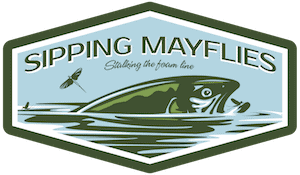Fly Fishing For Tilapia
June 29th, 2023
Yes, you read that correctly. This article is all about fly fishing for tilapia and strategies you can use to get this exotic food fish into your net.
Tilapia are an invasive species of cichlid from Africa, but rogue populations do exist and reproduce within the United States.
There aren’t many anglers chasing this species with a fly. However, I inadvertently stumbled upon a population of them and naturally grabbed my fly rod. More on that later.
After having caught hordes of them, I’m confident I can give you some tips so that when and if you encounter this species, you’ll be ready to catch your fill.
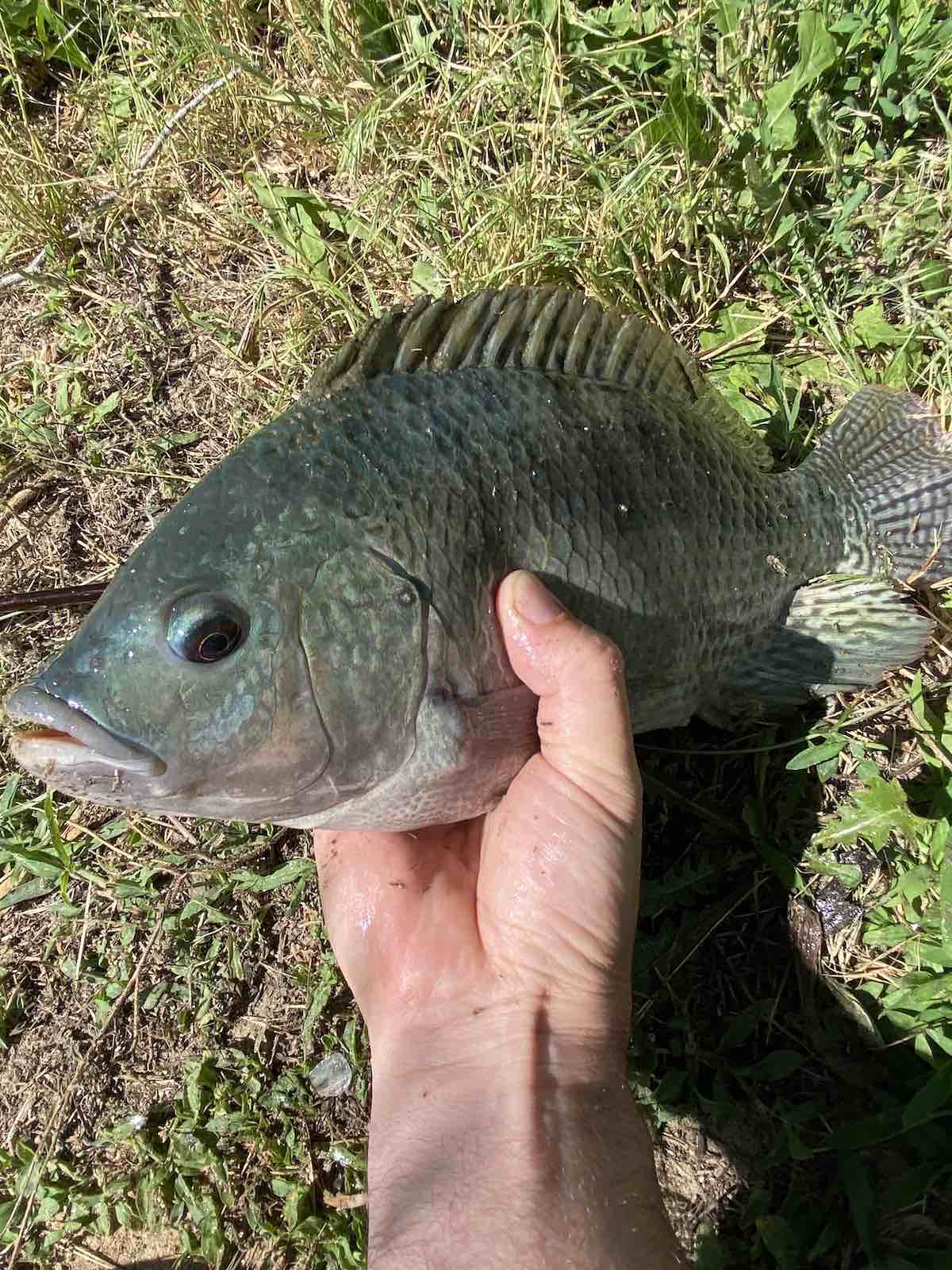
Here’s a large blue tilapia I caught on a terrestrial fly during the summer. It was a strong fish that made several runs.
Tilapia Facts
Tilapia are African cichlids and, as such, they’re mouth-brooders. This means the female will collect her eggs into her mouth, and spit them out so the male can fertilize them. Once the eggs are fertilized, she once again gathers the eggs into her mouth. She then allows the eggs to incubate and hatch inside her mouth.
There are over 100 different species of tilapia, but there are only three species found with regularity within the United States. More on that below.
These fish are the fourth most popular food fish in America, partially because they are simple to raise in an aquaponics system, and they can withstand poor water conditions. Their flesh has a mild taste.
Where to Find Tilapia
The species of tilapia that you’re most likely to encounter is the Blue tilapia (Oreochromis aureus). It’s the most prolific of the three main tilapia species found within the United States.
There are two other much less populous species invasive to the US, including the Nile tilapia (Oreochromis niloticus) and the Mozambique tilapia (Oreochromis mossambicus). All three species can hybridize, which can further complicate identification.
Florida and Texas are hotspots for the blue tilapia, but this species is also peppered throughout Arizona, Oklahoma, Idaho, Colorado, southern Nevada, and several coastal states in the southeast.
Nile tilapia are found across most of Florida, but are also found in Texas, Utah, Arizona, Lake Erie, and several gulf coast states.
Mozambique tilapia are found sporadically across the entire country, but are concentrated in southern California, Arizona, and Florida.
Arkansas stocks quite a few ponds with tilapia to help control algae growth, and to provide fishing opportunities.
Believe it or not, tilapia are on the IUCN’s list of the 100 worst alien invasive species. If you catch one, you might consider donating it to the local fauna.
Here are three USGS (United States Geological Survey) distribution maps showing the estimated distribution of tilapia throughout the United States. The first map represents the Blue tilapia, followed by the Nile tilapia, and finally the Mozambique tilapia.
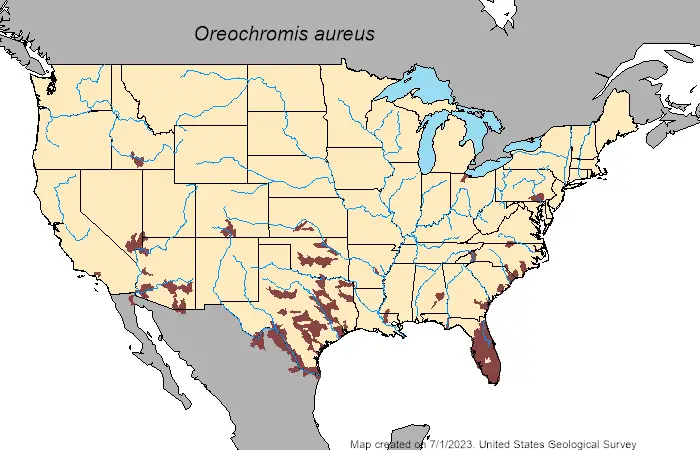

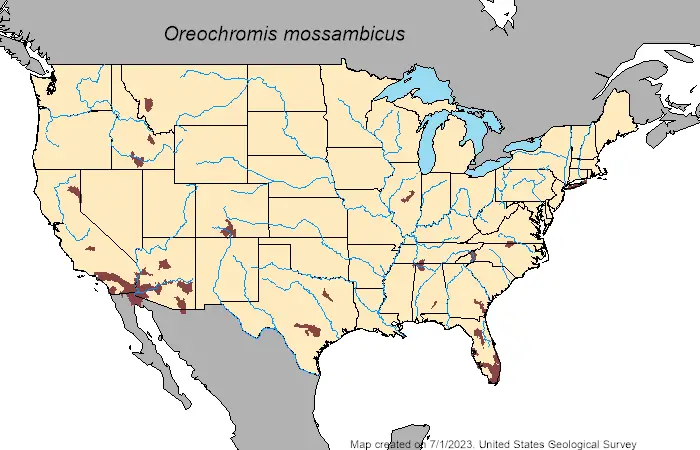
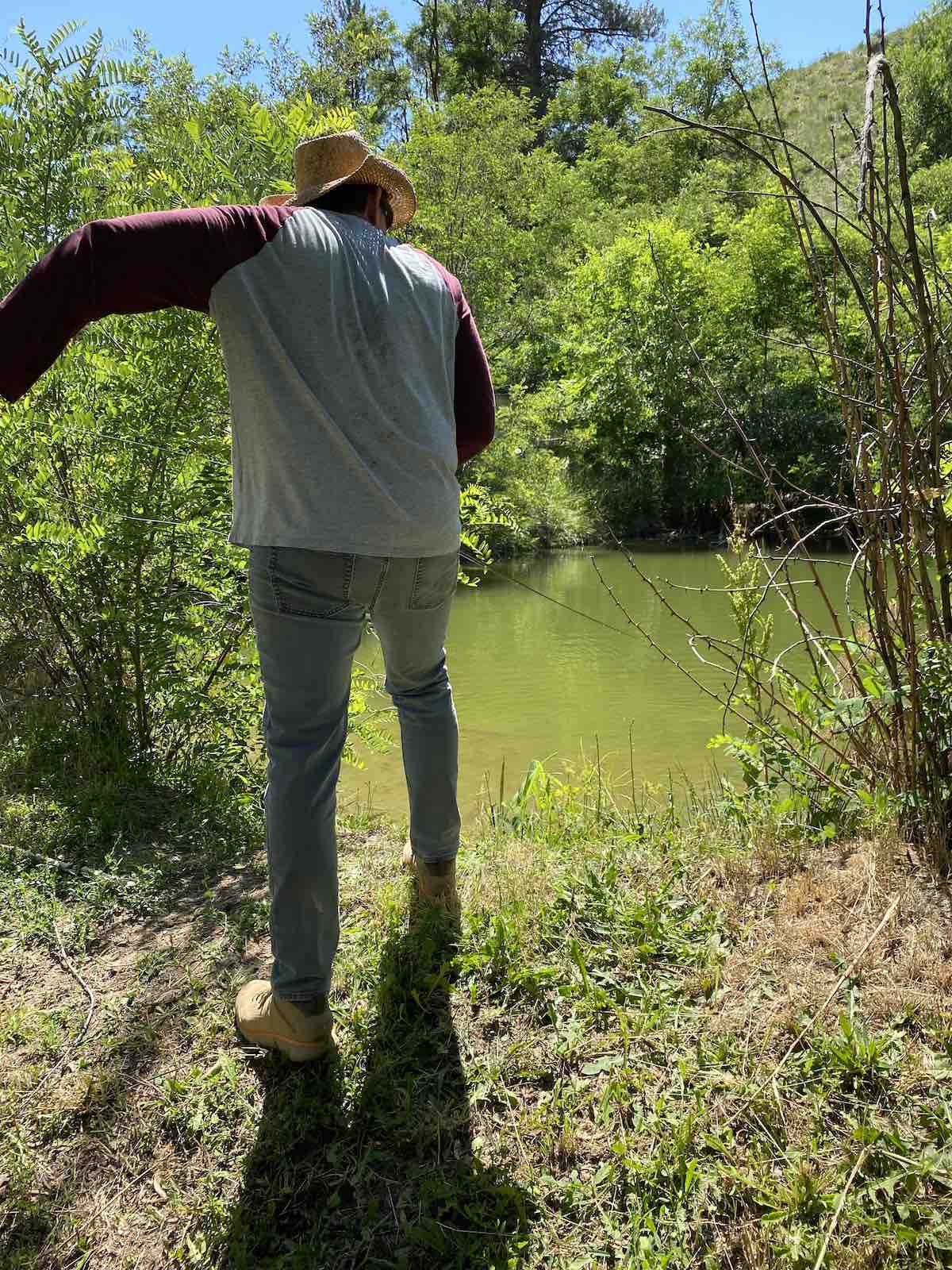
Here’s one of several ponds I found with populations of blue tilapia eager to take my flies. The hard part was casting amongst the brush, trees, and thorns. Above my head are tall trees.
TILAPIA HABITAT
First of all, focus on freshwater. Certain populations of tilapia can survive in brackish water, and reproducing populations even exist in the Salton sea (which is saltier than the ocean), but these are the exceptions.
Secondly, focus on warm water.
Most species of tilapia will perish when the water temperatures hit between 53F and 63F. Blue tilapia can take colder temperatures down to 50F. But as a rule, they do best in water that’s 75F to 80F.
When given this type of environment with plenty of food, they’ll grow quickly and will reproduce successfully.
After doing some research, I discovered that the ponds I was fishing were planted with tilapia over 15 years ago. But, several years ago the fish farm was abandoned and the tilapia were left to live (or die) on their own. As the generations came and went, they weren’t eaten or sold.

Here’s another picture of the abandoned pond I was fishing. It would’ve been nice to have been able to cast from that dock in its prime.
Tips on How to Fly Fish for Tilapia
Believe it or not, tilapia are considered herbivores. This means they primarily eat plant matter, including algae and submerged weeds.
But, the juveniles will also ravenously eat mosquito larvae.
What I learned by watching them in the ponds is that when an insect fell into the water, the fish were very opportunistic. They’d pound the bug. So, I’d personally call these fish omnivores, not herbivores.
So, I tied-on a terrestrial fly pattern and began casting.
Using roll casts, bow-and-arrow casts, and the occasional back cast (gambling that I wouldn’t get hung up), I began catching tilapia.
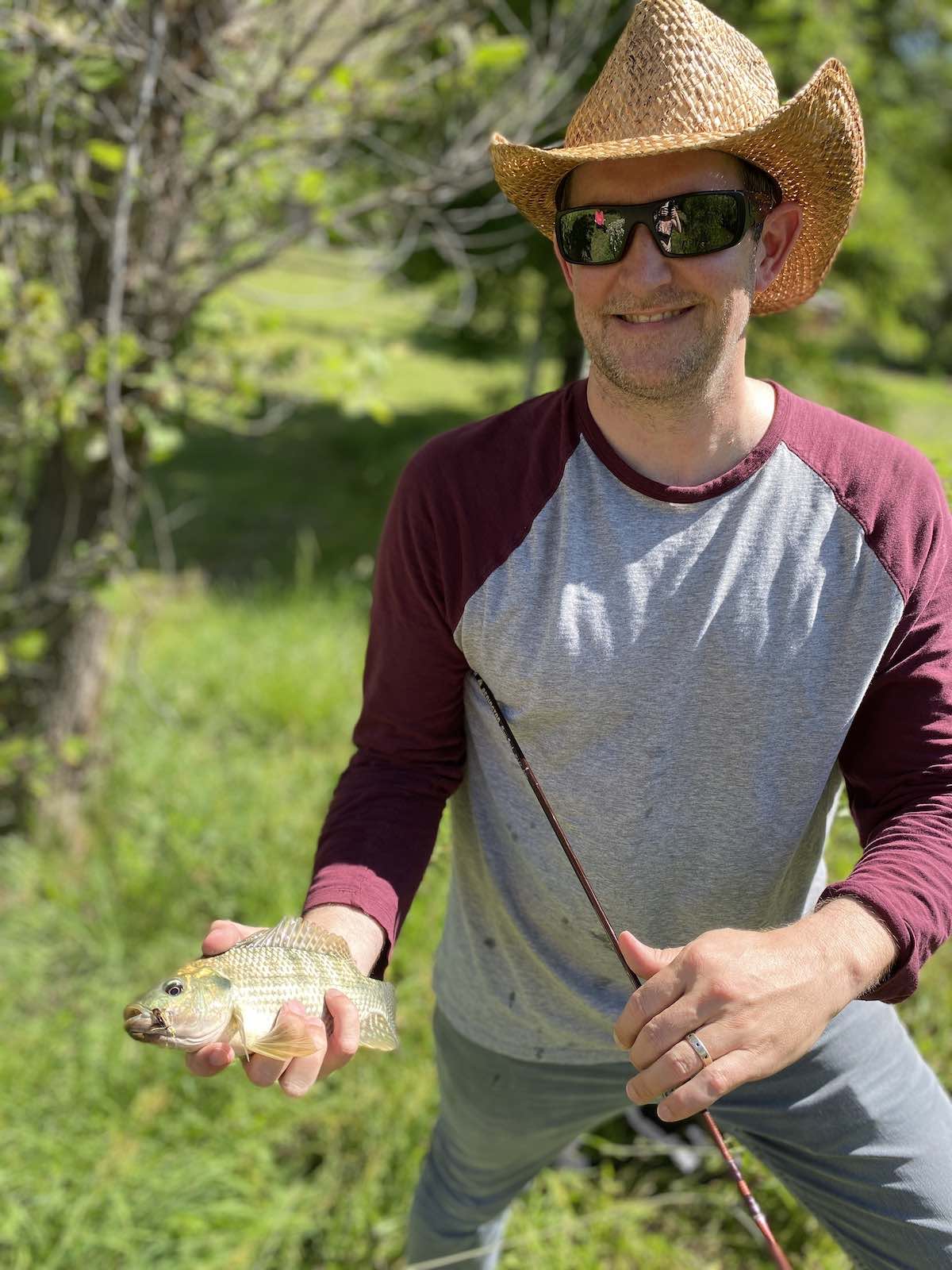
In the above picture you can see the first of many blue tilapia that took my terrestrial fly over the course of two days. This one was on the small side, but feisty nonetheless.
I’m convinced that any hopper-style pattern would’ve worked just as well as the fly I was using.
My tactic once the fly hit the water was to let it sit for just a few seconds.
Then, I’d use my rod to twitch the fly towards me 3-6 inches, wait a few seconds, then repeat.
Nearly every cast garnered attention.
As is always the case, the juveniles were far easier to fool into eating.
But, I wanted to catch the handful of big tilapia in the pond. For starters, I tied-on a bigger version of the same fly pattern so the smaller fish couldn’t inhale it.
The big tilapia would notice my fly, but would consistently demur at the last moment. I began to notice that they’d lose interest when I stopped moving the fly.
New plan.
When I got the attention of the next large fish, I slowed down my retrieve, but kept it moving. Instead of twitching the fly 3-6 inches at a time, I smoothly pulled the fly towards me at a slower pace.
That was the ticket.
I hooked into three big ones over the ensuing hour or so, but each of them threw the hook. My guess was that my rod set wasn’t strong enough to drive the hook home in their tough jaws.
So, I actually started strip-setting and that was the key.
The bigger blue tilapia I was catching would pull hard, and I’d need to muscle them in to prevent them from running into the submerged structures. Once I got them near the shoreline, they’d make another fast run in a straight line for the center of the pond. They’d do this repeatedly before I was able to land them.
Their dorsal spines are sharp–noticeably sharp, so be careful. I was poked several times and it wasn’t pleasant.
The Best Fly Patterns for Tilapia
I’m going to keep this section short, because there’s no need for it to be lengthy.
I learned quickly that tilapia aren’t discriminating eaters. While you can read online research telling you they’re primarily algae and weed eaters, they’re actually extremely opportunistic and will devour insects.
Dry Flies
If you’re into dry flies like I am, I’d highly recommend any terrestrial pattern. I only used one terrestrial dry fly because it never stopped working, but I’m extremely confident I could’ve been using any number of patterns.
For instance, I think an elk hair caddis fly would be super productive, as would most hopper patterns. Specifically, these hoppers on Amazon would work very well.
The reason I wouldn’t recommend dries such as BWOs, PMDs, and the like, is because they’re small and the juvenile tilapia will crush them before the big fish can get into the mix.
Don’t miss my article on what I consider the best fly floatant on the market.
Nymphs
The last day I fished the tilapia ponds, I decided to tie on a beadhead pheasant tail nymph and strip it back to me like a tiny streamer. It worked wonders, and further convinced me these fish will eat anything.
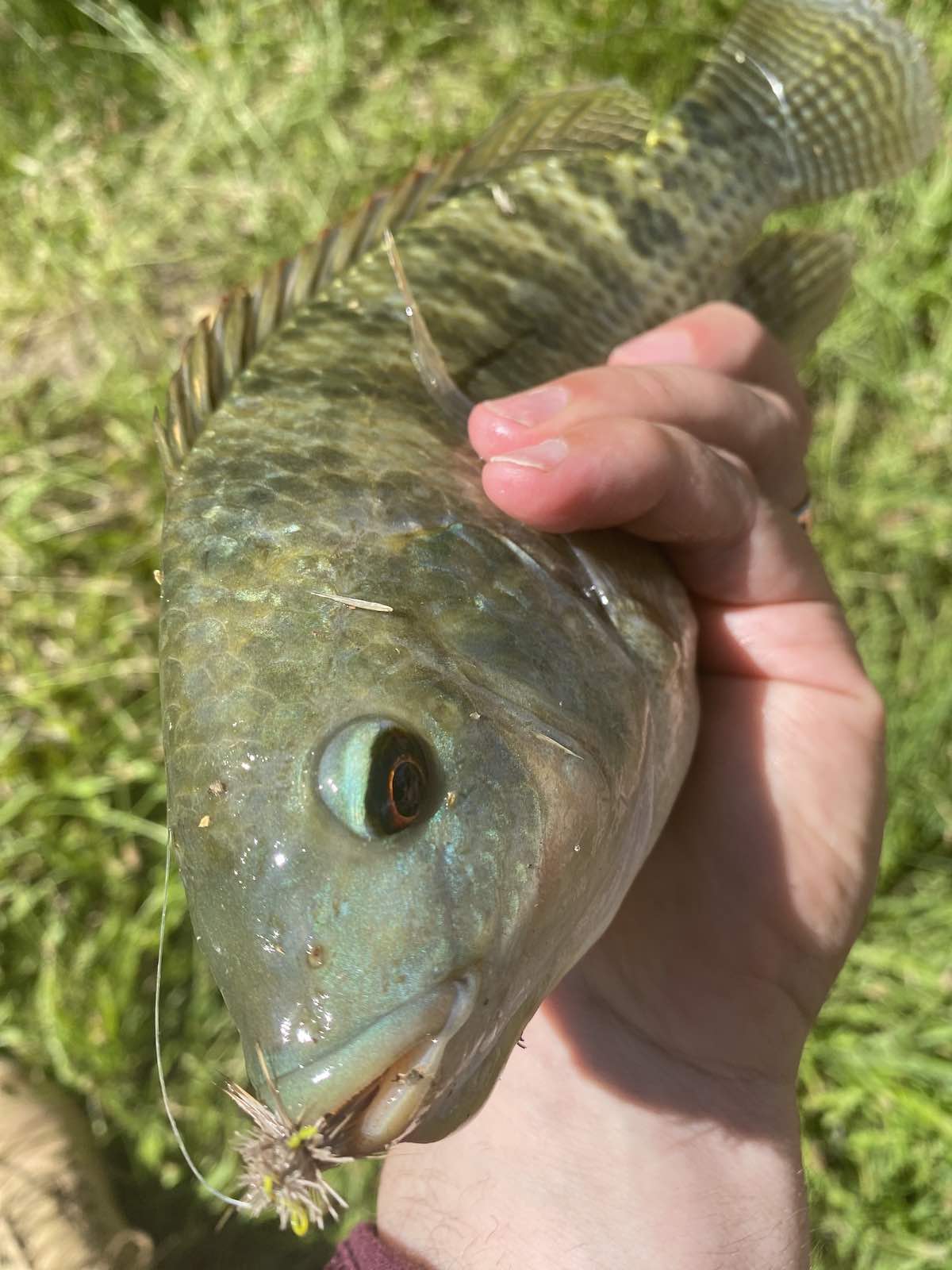
Here’s an aggressive blue tilapia that hit my terrestrial pattern hard.
Recommended Fly Gear
Fly Rod
You’ll want an 4 or 5-weight fly rod for medium-to-large tilapia. Personally, I use a 5-weight because it helps me land the fish faster and allows me to apply some muscle when needed.
The rod length should be 8.5 to 9-feet.
I can personally recommend the Redington Classic fly rods. They’re high quality and affordable, and it’s the rod that’s always in my car just in case.
Fly Reel
It’s unlikely any tilapia you’ll catch will take out much line–just the very biggest ones. Generally you can just strip them in. This means the reel you use isn’t very important, being that it’ll be more of a line storage device than anything else.
Fly Line
Match the weight of your line to your rod. So, if you use a 5-weight rod, use 5-weight fly line.
I’d highly recommend weight-forward floating line, since you’ll be able to cast dry flies, as well as streamers and nymphs.
Leader & Tippet
Tilapia aren’t leader shy at all. So, I’d recommend going a little heavier with your leader and tippet.
Specifically, I’d recommend nothing lighter than 4X, but 2X or 3X is even better in my opinion. It’ll allow you to muscle these thick fish out of cover and structure.
General Gear
If you’re curious, check out the best fly fishing slingpack I’ve ever used. It’s what I use to this day–I’ve never found anything better.
A good pair of forceps will come in very handy. If you don’t already have a pair, I wrote an article explaining the best fly fishing forceps and how to use them.
This is an important tool because tilapia have tough jaws and removing barbed hooks can take some effort. It’ll also allow you to get the fish back into the water faster, which is an advantage with all species.
Crushing your hook’s barb (also done with forceps) will make removing flies much faster.
Summary
Fly fishing for tilapia isn’t the most challenging scenario you’ll face on the water, but they’re strong fish and the action can be constant. It’s also a lot of fun to catch an exotic species that’s rarely found or caught in local waters.
They aren’t going to peel much line off your reel, but the bigger ones can weigh several pounds and will make repeated runs to deeper water. They don’t get much respect in the fly fishing world, but I’m happy to chase them once in a while, to mix things up.
Now get out there and find a tilapia pond!
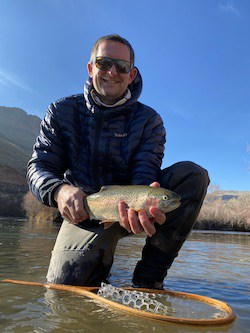
About the Author
My name's Sam and I'm a fly fishing enthusiast just like you. I get out onto the water 80+ times each year, whether it's blazing hot or snow is falling. I enjoy chasing everything from brown trout to snook, and exploring new waters is something I savor. My goal is to discover something new each time I hit the water. Along those lines, I record everything I learn in my fly fishing journal so I can share it with you.
Follow me on Instagram , YouTube, and Facebook to see pictures and videos of my catches and other fishing adventures!
